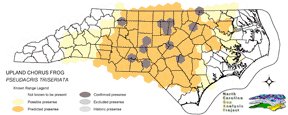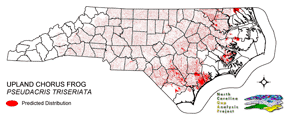
| Taxa: |
| Order: |
| Family: |
| Amphibia |
| Anura |
| Hylidae |
| NatureServe Global Rank: |
| NatureServe State (NC) Rank: |
| G5 |
| S5 |
| Federal Status: |
| NC State Status: |
| --- |
| --- |


| Land Unit |
| US Fish & Wildlife Service |
| US Forest Service |
| US National Park Service |
| US Department of Defense |
| NC State Parks |
| NC University System |
| NC Wildlife Res. Com. |
| NC Forest Service |
| NC Div. of Coastal Mgmt. |
| Local Governments |
| Non-Governmental Org. |
| Other Public Lands |
| Private Lands |
| GAP Status 1-2 |
| All Protected Lands |
| Statewide |
| Hectares |
| 22,079.79 |
| 5,689.98 |
| 26,094.24 |
| 108.18 |
| 13,075.56 |
| 868.41 |
| 45,650.79 |
| 6,864.39 |
| 0.00 |
| 820.26 |
| 2,430.27 |
| 718.20 |
| 1,305,875.16 |
| 79,153.56 |
| 122,154.57 |
| 1,430,275.23 |
| Acres |
| 54,560.34 |
| 14,060.24 |
| 64,480.26 |
| 267.32 |
| 32,310.41 |
| 2,145.89 |
| 112,805.54 |
| 16,995.63 |
| 0.00 |
| 2,026.91 |
| 6,005.33 |
| 1,774.71 |
| 3,226,887.17 |
| 195,626.03 |
| 301,883.82 |
| 3,534,319.73 |
| % of Dist. on |
| Prot. Lands |
| 18.1 % |
| 4.7 % |
| 20.1 % |
| < 0.1 % |
| 10.7 % |
| 0.7 % |
| 37.2 % |
| 5.6 % |
| 0.0 % |
| 1.9 % |
| 1.9 % |
| 0.2 % |
| 0.0 % |
| 64.8 % |
| ----- |
| ----- |
| % of Dist. on |
| All Lands |
| 1.5 % |
| 0.4 % |
| 1.8 % |
| < 0.1 % |
| 0.9 % |
| < 0.1 % |
| 3.2 % |
| 0.5 % |
| 0.0 % |
| < 0.1 % |
| 0.2 % |
| < 0.1 % |
| 91.3 % |
| 5.5 % |
| ----- |
| ----- |
|
This species is found in the upper coastal plain and piedmont of North Carolina (Martof et al. 1980). Scattered populations are found in Virginia's mountain region (Reay and Mitchell 1999), but none are know to occur in the mountains of North Carolina (Martof et al. 1980). This is essentially a forest species, occurring on floodplains and upland woods (Smith 1961). Occupies woodland and openland habitats in the vicinity of small pools and other moist habitats. They are found among grassy swales, moist woodlands, river bottom swamps, and in the vicinity of ponds, bogs, and marshes (Conant and Collins 1998). Preferred breeding sites include shallow water ponds, flooded woodlands and pastures, and roadside ditches (Redmond and Scott 1996). This species requires semi-permanent pools for breeding (Wilson 1995). It lays eggs on vegetation or submerged sticks (Smith 1961). NATURE SERVE GLOBAL HABITAT COMMENTS: Vicinity of breeding pools and moist habitats nearby. When inactive, hides in water, thick vegetation, under objects on ground, and in rodent burrows. |
| Code | Name | Description | NC Natural Heritage Program Equivalent |
| 121 | Maritime Pinelands | Loblolly forests and woodlands of the outer coastal plain. | Estuarine Fringe Loblolly Pine Forest |
| 17 | Maritime Forests and Hammocks | Maritime forests and woodlands dominated by live or sand laurel oak. Estuarine Fringe forests dominated by loblolly pine. | Coastal Fringe Evergreen Forest, Maritime Deciduous Forest, Maritime Deciduous Forest |
| 126 | Interdune Wooded Depression Swamp | Includes swamps dominated by sweetbay and swampbay or dogwood dominated forests. | Maritime Shrub Swamp, Maritime Swamp Forest |
| 173 | Coastal Plain Riverbank Shrubs | Shrub dominated riverbanks, commonly dominated by willows and/or alders. | Sand and Mud Bar |
| 50 | Coastal Plain Mixed Bottomland Forests | Includes forests dominated by a variety of hardwood species, including sweetgum, cottonwood, red maple. | Coastal Plain Bottomland Hardwood (in part), Coastal Plain Levee Forest |
| 49 | Coastal Plain Oak Bottomland Forest | Bottomland forests dominated by deciduous oak alliances. Oaks represented can include swamp chestnut, cherrybark, willow, and/or overcup oak. Inclusions of loblolly pine temporarily flooded forests occur in patches. Hydrology is temporarily to seasonally flooded. | Coastal Plain Bottomland Hardwoods (in part) blackwater subtype, brownwater subtype |
| 158 | Coastal Plain Nonriverine Wet Flat Forests | Loblolly pine - Atlantic white-cedar - red maple - swamp tupelo saturated forests as well as forests dominated by loblolly, sweetgum, and red maple in non-riverine flats. | Non-riverine Wet Hardwood Forest |
| 41 | Peatland Atlantic White-Cedar Forest | Dense stands of Atlantic white cedar with saturated hydrology. Can include swamp tupelo, red maple, and pond pines with a moderate shrub and herb layer. | Peatland Atlantic White-Cedar Forest |
| 15 | Seepage and Streamhead Swamps | Includes extensive peat flats in the coastal plain, dominated by swamp tupelo, maples, and Atlantic white cedar alliances. In the sandhills includes streamhead pond pine and bay forests alliances. Saturated hydrology. | Bay Forest, Small Depression Pocosin, Streamhead Atlantic White Cedar Forest, Streamhead Pocosins |
| 385 | Oak Bottomland Forest and Swamp Forest | The swamp chestnut oak, cherrybark oak, shumard oak and sweetgum alliance is one representative. Other alliances are dominated by water, willow, and overcup oaks. Swamp forests can be dominated by sweetgum, red maple, and black gum being dominant. Loblolly can occur in combination with sweetgum and red maple, or with tulip poplar. Includes saturated and semi- to permanently flooded forests in the mountains. | Piedmont/Mountain Bottomland Forest, Piedmont/Mountain Swamp Forest |
| 63 | Coastal Plain Mesic Hardwood Forests | Beech dominated forests with white oak and northern red oak as possible co-dominants. Dry-mesic to mesic forests on slopes and small stream bottoms in the coastal plain. | Mesic Mixed Hardwood Forest, Basic Mesic Forests |
| 87 | Pocosin Woodlands and Shrublands | Includes pond pine woodland, low pocosin and high pocosin shrub dominated areas. Canebrakes and bay forests may be present. | Pond Pine Woodlands, Peatland Canebrake, Small Depression Pocosin |
| 67 | Wet Longleaf or Slash Pine Savanna | Wet flatwoods and pine savannas, typically dominated by longleaf pines, but slash or pond pines may be the dominant pines. | Wet Pine Flatwoods |
| 267 | Riverbank Shrublands | Riverside shrubs with temporarily flooded hydrologies. Found in the both the Mountains and Piedmont. Containing dominants such as smooth alder and a Carolina or black willows. | Sand and Mud Bar |
| 269 | Floodplain Wet Shrublands | Saturated shrublands of the Piedmont, includes buttonbush, swamp-loosestrife, decodon and alders. | Piedmont/mountain Semipermanent Impoundment |
| 230 | Piedmont Mesic Forest | American Beech - Red Oak - White Oak Forests. | Mesic Mixed Hardwood |
| 384 | Piedmont/Mountain Mixed Bottomland Hardwood Forests | Includes temporarily to seasonally forests dominated by hardwood species. Hardwoods include sweetgum, red maple, sycamore which co-occur in a mosaic of bottomland and levee positions. Includes alluvial hardwood forests in the mountains. Hemlock and white pine may occur as inclusions, but are generally mapped separately. | Piedmont/Mountain Alluvial Forest, Piedmont/Mountain Levee Forest |
| 383 | Piedmont Mixed Successional Forest | Generally loblolly mixed with successional hardwoods. Sweetgum, tulip poplar and red maple are common co-dominants in these successional forests. | No equivalent |
| 517 | Hemlock Floodplain Forest | Alluvial forest with hemlock and/or white pine in mountains and western piedmont. Hydrology is generally temporarily to seasonally flooded. | Canada Hemlock Forest |
| 527 | Appalachian Hemlock | Upland hemlock forests of the moutains region. Vary from side slopes to steep slope positions. | Canada Hemlock Forest |
| 533 | Appalachian Swamp Forest | Evergreen and deciduous forests with saturated hydrologies. This class may contain a variety of trees species, including hemlock - red maple, pitch pine, and white pine forests. | Swamp Forest-Bog Complex, Southern Appalachian Bog, Southern Appalachian Fen |
| 534 | Appalachian Wet Shrubland/ Herbaceous | Saturated shrubs and herbaceous vegetation. Often mapped as an inclusion in Appalachian Swamp Forest. | Southern Appalachian Bog, Southern Appalachian Fen |
|
Platz, J. E., and D. C. Forester. 1988. Geographic variation in mating call among the four subspecies of the chorus frog:PSEUDACRIS TRISERIATA (Wied). Copeia 1988:1062-1066.
Conant, R. and J. T. Collins. 1991. A field guide to reptiles and amphibians:eastern and central North America. Third edition. Houghton Mifflin Co., Boston, Massachusetts. 450 pp. Karns, D. R. 1992. Effects of acidic bog habitats on amphibian reproduction in a northern Minnesota peatland. J. Herpetol. 26:401-412. Reay, K. K., and J.C. Mitchell. 1999. Atlas of amphibians and reptiles in Virginia (1). Richmond, VA: Virginia Dept. Game and Inl. Fisheries. Wilson, L. A. 1995. The Land Manager's Guide to the amphibians and reptiles of the South. Chapel Hill, NC: The Nature Conservancy. Redmond, W. H., and A. F. Scott. 1996. Atlas of amphibians in Tennessee. The Center for Field Biology, Austin Peay State University, Miscellaneous Publication Number 12. v + 94 pp. Platz, J. E. 1989. Speciation within the chorus frog PSEUDACRIS TRISERIATA:morphometric and mating call analyses of the boreal and western subspecies. Copeia 1989:704-712. Cocroft, R. B. 1994. A cladistic analysis of chorus frog phylogeny (Hylidae:PSEUDACRIS). Herpetologica 50:420-437. Smith, D. W. 1961. The amphibians and reptiles of Illinois. Illinois Natural History Survey Bulletin 28(1)1-298. Minton, S. A., Jr. 1972. Amphibians and reptiles of Indiana. Indiana Academy Science Monographs 3. v + 346 pp. Mount, R. H. 1975. The Reptiles and Amphibians of Alabama. Auburn University Agricultural Experiment Station, Auburn, Alabama. vii + 347 pp. Johnson, T. R. 1977. The amphibians of Missouri. Univ. Kansas Mus. Nat. Hist., Pub. Ed. Ser. 6. ix + 134 pp. Martof, B. S., W. M. Palmer, J. R. Bailey, and J. R. Harrison, III. 1980. Amphibians and reptiles of the Carolinas and Virginia. University of North Carolina Press, Chapel Hill, North Carolina. 264 pp. Vogt, R. G. 1981. Natural history of amphibians and reptiles of Wisconsin. Milwaukee Public Museum. 205 pp. Collins, J. T. 1982. Amphibians and reptiles in Kansas. Second edition. Univ. Kansas Mus. Nat. Hist., Pub. Ed. Ser. 8. xiii + 356 pp. Hammerson, G. A. 1982. Amphibians and reptiles in Colorado. Colorado Division of Wildlife, Denver. vii + 131 pp. Collins, J. T. 1990. Standard common and current scientific names for North American amphibians and reptiles. SSAR Herpetol. Circular No. 19. 41 pp. White, H.B. 1971. New England dragonflies. Maine Field Naturalist. 27(4):8-14. |
For more information please contact them at:
NC-GAP Analysis Project
Dept. of Zoology, NCSU
Campus Box 7617
Raleigh, NC 27695-7617
(919) 513-2853
www.basic.ncsu.edu/ncgap